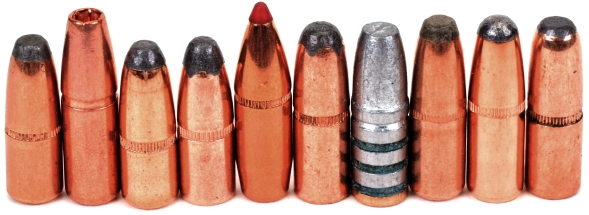
The 30-30 Winchester cartridge, in recent times, has been much maligned. But then that is becoming the way in America; a person with no direct experience with a subject makes an unsupported criticism, then solicits the concurrence of fifty other ninnies, and the product of that group grope is labeled fact, or even law.
I personally like the 30-30 WCF for lots of reason… besides the fact that the chamber shows up in some if my favorite old rifles. I’ve used the 30-30 WCF for many years as my primary deer and hog rifle, never had to shoot more than once at game and never had anything run more than a few feet before expiring. I’ve taken it along as a backup on hunting trips and dragged it out and used it successfully when more expensive, more powerful firearms malfunctioned.
Hunting range limited to 100 yards… Really?
A discouraging word that is often heard, but not supported by the exterior ballistics appearing on the table below. No, all 30-30 Winchester ammo does not perform the same, however, there are many that come very close.
| Hornady 30-30 Win 160 Grain FTX LEVERevolution | ||||
| Yards | 0 | 100 | 200 | 300 |
| Velocity fps | 2400 | 2150 | 1916 | 1699 |
| Energy ft-lb | 2046 | 1643 | 1304 | 1025 |
| Trajectory “ | -1.5 | 3.0 | 0.0 | 12.1 |
According to the bullet, rather than opinion, with the correct bullet selection the 30-30 Winchester is easily a 300 yard dear cartridge and it is effective on hogs and black bear at some lesser distances. Yes, caribou, elk and moose and other large specie have routinely been dropped with the 30-30 Winchester, but I won’t attempt to secure that general acceptance.
The 30-30 WCF is boring. Not it’s not.

The 30-30 Winchester is a moderate capacity cartridge. It has eleven less grains of capacity than the 308 Winchester and the 30-30 Winchester also operates at nearly one third less pressure; 42,000 Vs. 62,000 psi, in deference to the typical simple lever action rifles made in this chamber. Around since 1895, my suspicions are that some folks have found the cartridge to be… useful.
The 30-30 WCF is not a rocket, nor will it ever become one. Pushing pressure from the SAAMI PMAP standard of 42,000 psi to the CIP standard of 46,412 psi is worth approximately 60 fps. Beyond that, the velocity yield on pressure falls away quickly. There is also no advantage to using expensive Buffalo Bore or HSM hot loaded factory ammo as the velocity is quite standard.
Hornady’s LEVERevolution product does put an edge on the 30-30 Winchester’s by increasing velocity with a proprietary smokeless powder and by utilizing Flex Tip bullets with enhanced ballistic coefficient that are safe to use in tubular magazine rifles. Both FTX bullets and LEVERevolution powder are also available as components for the handloader.
|
Hornady – Winchester Factory Ammunition Comparison |
|||||
|
Yards |
0 | 100 | 200 | 300 | |
| Hornady FTX 160 Grain | Velocity fps | 2400 | 2150 | 1916 | 1699 |
| Winchester Ballistic Silvertip150 Grain | Velocity fps | 2390 | 2040 | 1723 | 1447 |
| Hornady FTX 160 Grain | Energy ft-lb | 2046 | 1643 | 1304 | 1025 |
| Winchester Ballistic Silvertip 150 grain | Energy ft-lb | 1902 | 1386 | 989 | 697 |
| Hornady FTX 160 Grain | Trajectory “ | -1.5 | 3.0 | 0.0 | 12.1 |
| Winchester Ballistic Silvertip 150 grain | Trajectory” | -1.5 | 3.8 | 0.0 | 15.6 |
Five standards for the do it yourselfer…
The thing with factory ammunition is that it is subjected to manufacturer’s standards and policies that can often be neutralized by the handloader without violating SAAMI standards. Performance can also be improved where each individual components is not restricted to a single brand. In this case we began with five different bullets, each bringing something to the effort.

| Bullet | Type | Weight Grains |
Length “ | Seat Depth “ |
COL |
| Barnes X | HP | 150 | 1.065 | 0.630 | 2.475 |
| Speer | FNSP | 150 | 0.922 | 0.411 | 2.550 |
| Hornady | FTX | 160 | 1.130 | 0.619 | 2.550 |
| Oregon Trail Cast | FN | 170 | 0.980 | 0.479 | 2.540 |
| Sierra | FN | 170 | 1.012 | 0.520 | 2.515 |
The Barnes bullet, in this form or Triple Shock version fits in “no lead” states and it is a good performing bullet in terms of ballistic coefficient and reliable expansion at 30-30 WCF velocity levels. The Speer bullet is a traditional 150 grain flat nose, jacketed lead core bullet, a 30-30 WCF mainstay; good controlled expansion and, as the others, safe in a tubular magazine. Some folks like cast bullets. They are typically relatively low in cost, deep penetrating and accurate. The Sierra jacketed flat nose is relatively heavy construction within the 30-30 WCF line up and works well.

Email Notification